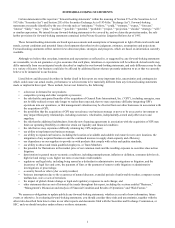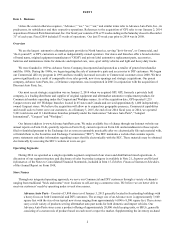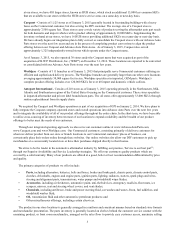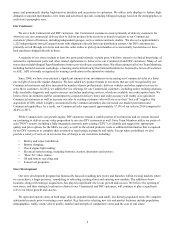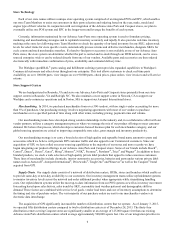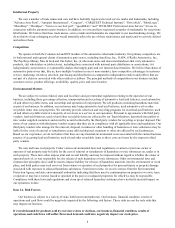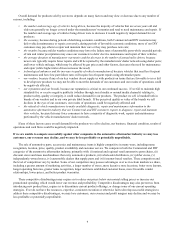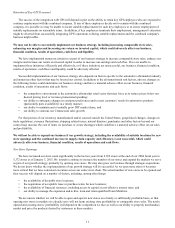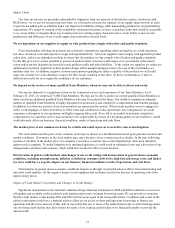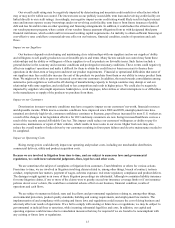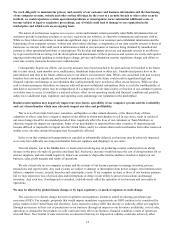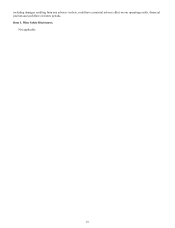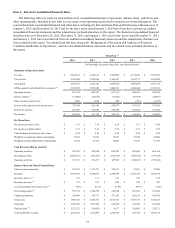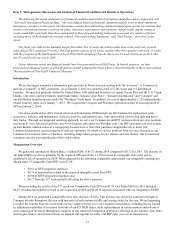Advance Auto Parts 2014 Annual Report Download - page 18
Download and view the complete annual report
Please find page 18 of the 2014 Advance Auto Parts annual report below. You can navigate through the pages in the report by either clicking on the pages listed below, or by using the keyword search tool below to find specific information within the annual report.11
Retention of Key GPI Personnel
The success of the integration with GPI will depend in part on the ability to retain key GPI employees who are expected to
continue employment with the combined company. If any of these employees decide not to remain with the combined
company, it is possible we may be unable to locate suitable replacements for such key employees or to secure employment of
suitable replacements on reasonable terms. In addition, if key employees terminate their employment, management’s attention
might be diverted from successfully integrating GPI’s operations to hiring suitable replacements and the combined company's
business might suffer.
We may not be able to successfully implement our business strategy, including increasing comparable store sales,
enhancing our margins and increasing our return on invested capital, which could adversely affect our business,
financial condition, results of operations, cash flows and liquidity.
We have implemented numerous initiatives as part of our business strategy to increase comparable store sales, enhance our
margins and increase our return on invested capital in order to increase our earnings and cash flow. If we are unable to
implement these initiatives efficiently and effectively, or if these initiatives are unsuccessful, our business, financial condition,
results of operations, cash flows and liquidity could be adversely affected.
Successful implementation of our business strategy also depends on factors specific to the automotive aftermarket industry
and numerous other factors that may be beyond our control. In addition to the aforementioned risk factors, adverse changes in
the following factors could undermine our business strategy and have a material adverse effect on our business, financial
condition, results of operations and cash flows:
• the competitive environment in the automotive aftermarket retail sector that may force us to reduce prices below our
desired pricing level or increase promotional spending;
• our ability to anticipate changes in consumer preferences and to meet customers’ needs for automotive products
(particularly parts availability) in a timely manner;
• our ability to maintain and eventually grow DIY market share; and
• our ability to continue our Commercial sales growth.
For that portion of our inventory manufactured and/or sourced outside the United States, geopolitical changes, changes in
trade regulations, currency fluctuations, shipping related issues, natural disasters, pandemics and other factors beyond our
control may increase the cost of items we purchase or create shortages which could have a material adverse effect on our sales
and profitability.
We will not be able to expand our business if our growth strategy, including the availability of suitable locations for new
store openings and the continued increase in supply chain capacity and efficiency, is not successful, which could
adversely affect our business, financial condition, results of operations and cash flows.
New Store Openings
We have increased our store count significantly in the last ten years from 2,652 stores at the end of our 2004 fiscal year to
5,372 stores as of January 3, 2015. We intend to continue to increase the number of our stores and expand the markets we serve
as part of our growth strategy, primarily by opening new stores. We may also grow our business through strategic acquisitions.
We do not know whether the implementation of our growth strategy will be successful. As we open more stores it becomes
more critical that we have consistent execution across our entire store chain. The actual number of new stores to be opened and
their success will depend on a number of factors, including, among other things:
• the availability of desirable store locations;
• the negotiation of acceptable lease or purchase terms for new locations;
• the availability of financial resources, including access to capital at cost-effective interest rates; and
• our ability to manage the expansion and to hire, train and retain qualified Team Members.
We are unsure whether we will be able to open and operate new stores on a timely or sufficiently profitable basis, or that
opening new stores in markets we already serve will not harm existing store profitability or comparable store sales. The newly
opened and existing stores’ profitability will depend on the competition we face as well as our ability to properly merchandise,
market and price the products desired by customers in these markets.


